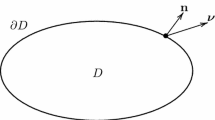Abstract.
The dynamic behavior of a reaction–diffusion model of solid-phase combustion is investigated by using the linear stability analysis method. The diffusion coefficients of the oxygen gas and the vapor of the combustible solid (Mg) are taken as two controlling parameters in the analysis. The bifurcation map obtained shows three dynamic regions. Region I only shows stable combustion. Regions II and III both show stable combustion and oscillatory combustion depending on the ratio of the two diffusion coefficients. Interestingly region II also shows a small range of a bistable state consisting of a stable focus and an oscillating state, which is like the critical phenomena in phase transitions. The results indicate that the occurrence of oscillating combustion requires that the value of the diffusion coefficient of the Mg vapor should be comparable to or less than that of the oxygen gas at the same temperature.
Similar content being viewed by others
Author information
Authors and Affiliations
Additional information
Received: 6 November 2001 / Accepted: 25 March 2002 / Published online: 13 June 2002
Rights and permissions
About this article
Cite this article
Zhu, R., Li, Q. Linear stability analysis of a reaction–diffusion model of solid-phase combustion. Theor Chem Acc 107, 357–361 (2002). https://doi.org/10.1007/s00214-002-0340-3
Issue Date:
DOI: https://doi.org/10.1007/s00214-002-0340-3




